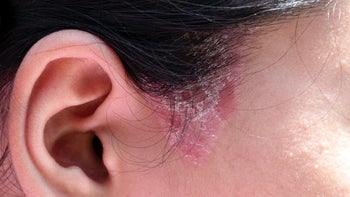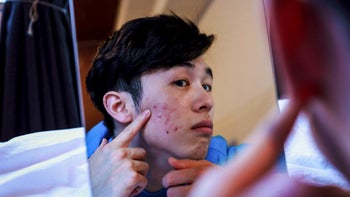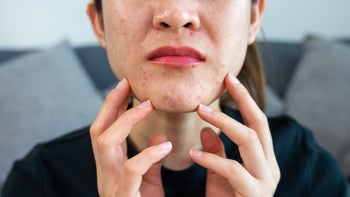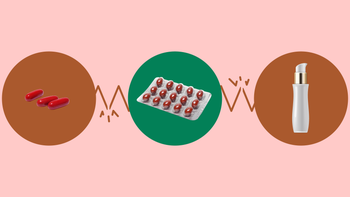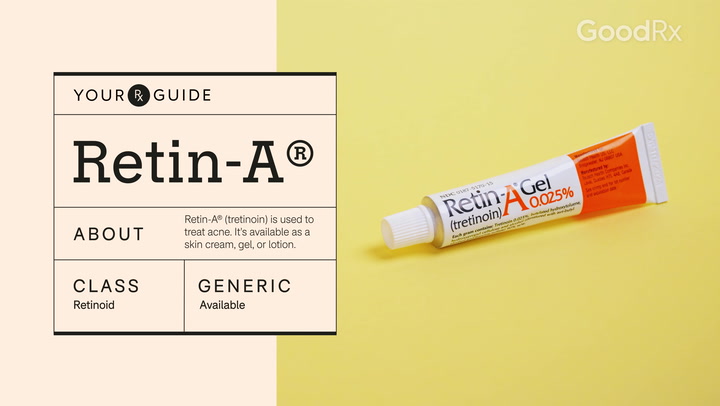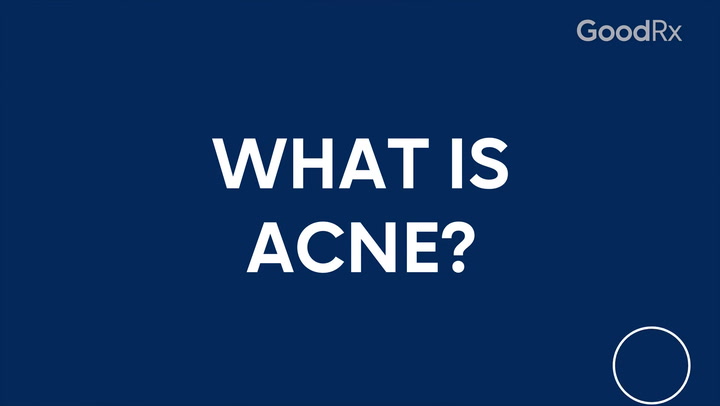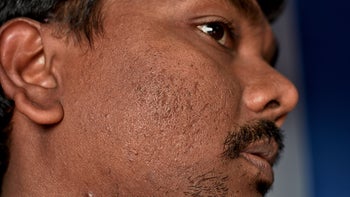
Tretinoin vs. Adapalene for Acne: What Are The Differences and Which Works Better?
Key takeaways:
Adapalene (Differin) and tretinoin (Retin-A) belong to a group of medications called retinoids. They’re first-choice treatment options for acne.
Both medications are available in multiple forms and dosages, but only adapalene 0.1% gel is available over the counter (OTC).
When comparing adapalene versus tretinoin for acne, some research shows they’re equally effective. But adapalene may cause less skin irritation than tretinoin.
Adapalene and tretinoin are both available in brand-name and generic forms. GoodRx can help you find ways to save money on your prescription, with exclusive savings on brand-name Retin-A products.
Access savings on related medications
Table of contents

Acne is the most common skin condition in the U.S., affecting up to 50 million Americans every year. Whether you started getting pimples as a teenager or didn’t experience acne until you were an adult, chances are you’ve dealt with this skin condition at some point. Luckily, many products and medications are available to treat acne.
Adapalene (Differin) and tretinoin (Retin-A) belong to the class of medications known as retinoids. These products are derived from vitamin A. They’re effective for treating and improving certain skin concerns, such as wrinkles and acne. They can also treat acne scars.
Both adapalene and tretinoin are available as topical products. They work similarly and share common side effects. But there are some differences, too. Keep reading for a comparison of tretinoin versus adapalene for acne.
Pay less for Retin-A
Save an average of over 40% off retail prices for Retin-A (tretinoin) when you use GoodRx, whether you have insurance or not.

1. Tretinoin and adapalene have different FDA approved uses
Adapalene is only FDA approved to treat mild-to-moderate acne. However, it’s used off-label for other health conditions, too. This means it’s used in ways that aren’t FDA approved. Examples of off-label uses include dark spots on the skin, certain types of hair loss, and wrinkles.
The FDA-approved uses for tretinoin depend on which product you’re using. The various tretinoin products are FDA approved to treat at least one of the following:
Acne
Facial wrinkles (Renova and generic forms)
Facial skin roughness
Dark spots on the face
Tretinoin is also used off-label in other skin conditions like keratosis pilaris (chicken skin) and actinic keratosis (a skin condition that can occur from excessive sun exposure).
2. They come in different forms
Adapalene comes in different forms. It’s available as adapalene 0.3% gel. It’s also available as several adapalene 0.1% products, including:
Gel
Cream
Liquid solution swab
Is adapalene or tretinoin better for wrinkles? Adapalene and tretinoin may be used off-label for wrinkles. Learn about which topical medication may be best for you.
Are retinoids safe? Find out how to use retinoids safely and correctly.
How do you apply a retinoid? Applying retinoid products correctly can help you avoid side effects including skin irritation.
All adapalene products are available as a generic.
Tretinoin is also available in several forms. The products that are FDA approved for acne are:
Cream (0.025%, 0.05%, and 0.1%)
Gel (0.01%, 0.025%) and micro-tretinoin gel (0.04%, 0.06%, 0.08%, and 0.1%)
Lotion (0.05%)
Read more like this
Explore these related articles, suggested for readers like you.
Tretinoin is available as a generic in cream and gel forms. There are also several brand-name products, including:
Renova cream is another tretinoin medication but it’s only FDA approved for wrinkles.
3. Adapalene is available over the counter, but tretinoin isn’t
No tretinoin forms are available over the counter (OTC). However, adapalene 0.1% gel is available OTC as a generic and brand-name product Differin. All the other forms of adapalene are available by prescription only.
4. They may be equally effective, but adapalene tends to cause less skin irritation
Adapalene and tretinoin are both considered first-choice options for treating acne. While we don’t have a lot of studies comparing the two medications for acne, we’ll review the available research below:
One review found that adapalene 0.1% gel caused less irritation than tretinoin 0.05% gel, but that tretinoin might be more effective
Other study found the adapalene 0.1% gel and tretinoin microsphere 0.1% gel were equally effective, but adapalene caused fewer side effects
Adapalene 0.1% gel was as effective as tretinoin 0.05% cream at improving acne, but caused fewer side effects
Based on this research, it’s not clear whether adapalene or tretinoin is a better option to treat acne. The takeaway is that both medications are likely effective, and it’s possible that adapalene is easier to tolerate than tretinoin.
But, when comparing adapalene 0.1% gel versus 0.3% gel, the 0.3% product is considered more effective at treating acne. Keep in mind that to use adapalene 0.3% gel, you’ll need a prescription from a healthcare professional.
5. Adapalene can be applied during the day, but tretinoin should only be applied at night
It’s typically best to apply retinoids at night. This is because light and air can deactivate some retinoid products. However, adapalene is considered least likely to have this problem, so it may be applied during the day if you need to.
Can you use adapalene and tretinoin together for acne?
No. You shouldn’t use adapalene and tretinoin together. These two medications work similarly for acne and can cause the same side effects.
If you use them together, you’re more likely to have skin irritation. Talk to a healthcare professional if you’re using adapalene or tretinoin but not seeing the results you’d like.
Do adapalene and tretinoin have any similarities?
Although we’ve discussed the differences of tretinoin versus adapalene, they also have several similarities. We’ll go into more detail below.
How they work
While adapalene and tretinoin may have structural differences leading to some potentially different effects, they largely work in the same way.
Many factors can lead to acne, but the main problem is clogged pores. Clogged pores can happen for a variety of reasons, including dead skin or oil building up in the pores. Retinoids work by preventing the buildup of dead skin cells and encouraging new, healthy skin to grow instead.
Retinoids also help treat inflammation that occurs with acne and promote the formation of collagen (proteins that contribute to the elasticity of the skin). This may help improve scars and dark spots left behind from acne breakouts.
Administration
Both medications are usually applied as a thin layer to the face once daily. Your prescriber might recommend that you start out by applying it every other day. Once you’re able to tolerate it, they may suggest applying the medication every day. Usually, a pea-sized amount of product is enough to cover the area with a thin layer.
Before applying retinoids, wash your face with a gentle cleanser, then let your skin dry completely. You should avoid getting the medication in your mouth, nose, and eyes. But applying it to the skin around your eyes is OK.
Retinoids can dry out your skin. After applying your retinoid, keep your skin hydrated with an oil-free moisturizer. It is also a good idea to wear an oil-free sunscreen while using retinoids, because your skin may be more sensitive to the sun as you’re getting used to the medication.
Side effects
When comparing adapalene side effects versus tretinoin side effects, they’re pretty similar. Both can cause:
Dry skin
Redness
Skin peeling
A burning sensation on the skin
Itchiness
Worsening skin appearance (including acne) when you first start the medication
However, as mentioned previously, adapalene may cause less skin irritation than tretinoin.
Serious risks
Adapalene and tretinoin both have the potential to cause intolerable skin irritation. Contact your prescriber if your skin irritation doesn’t go away after a few weeks of treatment or if your skin is severely irritated. They may recommend that you apply the medication less frequently, use a lower dose, or stop using it altogether.
Rarely, these products can cause serious allergic reactions. Symptoms may include swelling of the face, lips, or eyes. You might also develop hives or have trouble breathing. If you experience any of these reactions, stop using the medication and get medical help right away.
Tretinoin and adapalene may raise the risk of birth defects if used by pregnant women. The risk is low when using retinoids topically, but, generally, they aren’t recommended to be used during pregnancy unless necessary. If you become pregnant while using one of these medications, stop the medication and contact your prescriber.
Drug interactions
Adapalene and tretinoin may interact with other skin products that can cause irritation or dryness. This includes topical products containing salicylic acid, glycolic acid, and alcohol. But keep in mind that in some cases, other skin products when used correctly can be combined with adapalene and tretinoin to improve acne. For example, although benzoyl peroxide is an acne medication that can cause skin irritation, it can be combined with retinoids to treat acne. In fact, a combination gel product containing benzoyl peroxide and adapalene (Epiduo, Epiduo Forte) is available by prescription.
Brand-name Altreno lotion (a tretinoin product) should be avoided if you’re allergic to fish. It’s made with fish proteins, which could potentially cause a reaction in someone with fish allergies.
How to save on adapalene and tretinoin
Tretinoin and adapalene are available as both brand-name and generic products. And adapalene 0.1% gel is available OTC. GoodRx can help you find ways to save money on your prescription, with exclusive savings on brand-name Retin-A.
Anyone with a valid prescription, regardless of insurance status, can use GoodRx to purchase brand-name Retin-A cream for as little as $39.04 for a 45 gram tube. GoodRx also offers exclusive savings on Retin-A gel, with prices as low as $39.04 for a 45 gram tube.
Below, you’ll find a few generic adapalene and tretinoin prescription products. Here’s how much a 45 g tube of the following product may cost with a free GoodRx coupon:
Adapalene 0.1% gel: As low as $10.77
Adapalene 0.3% gel: As low as $30.00
Tretinoin 0.025% cream: As low as $32.00
Tretinoin 0.05% cream: As low as $34.01
Tretinoin microsphere 0.1% gel: As low as $158.12
The bottom line
Both adapalene (Differin) and tretinoin (Retin-A) are effective topical treatments for acne. They’re both retinoids that are derived from Vitamin A. Adapalene 0.1% gel is available OTC. But other adapalene products, and all tretinoin products, are available by prescription only.
When comparing tretinoin versus adapalene, they both work well for acne and have similar side effects. But adapalene may cause less skin irritation than tretinoin.
Why trust our experts?



References
American Academy of Dermatology Association. (n.d.). Skin conditions by the numbers.
Cunliffe, W. J., et al. (2002). Randomised, controlled trial of the efficacy and safety of adapalene gel 0.1% and tretinoin cream 0.05% in patients with acne vulgaris. European Journal of Dermatology.
Del Rosso, J., et al. (2023). Efficacy and safety of microencapsulated benzoyl peroxide and microencapsulated tretinoin for the treatment of acne vulgaris: Results from two phase 3 double-blind, randomized, vehicle-controlled studies. Journal of the American Academy of Dermatology.
Jain, S. (2004). Topical tretinoin or adapalene in acne vulgaris: An overview. Journal of Dermatological Treatment.
Leyden, J., et al. (2017). Why topical retinoids are mainstay of therapy for acne. Dermatology and Therapy.
Motamedi, M., et al. (2022). A clinician’s guide to topical retinoids. Journal of Cutaneous Medicine and Surgery.
Pariser, D. M., et al. (2005). The efficacy and safety of adapalene gel 0.3% in the treatment of acne vulgaris: A randomized, multicenter, investigator-blinded, controlled comparison. Cutis.
Reynolds, R. V., et al. (2024). Guidelines of care for the management of acne vulgaris. Journal of the American Academy of Dermatology.
Rusu, A., et al. (2020). Recent advances regarding the therapeutic potential of adapalene. Pharmaceuticals.
Target Corporation. (2024). ADAPALENE- adapalene gel [package insert].
Thiboutot, D., et al. (2001). Randomized controlled trial of the tolerability, safety, and efficacy of adapalene gel 0.1% and tretinoin microsphere gel 0.1% for the treatment of acne vulgaris. Cutis.
Thiboutot, D., et al. (2006). Adapalene gel 0.3% for the treatment of acne vulgaris: A multicenter, randomized, double-blind, controlled, phase III trial. Journal of the American Academy of Dermatology.
Tolaymat, L., et al. (2023). Adapalene. StatPearls.
Yoham, A. L., et al. (2023). Tretinoin. StatPearls.








